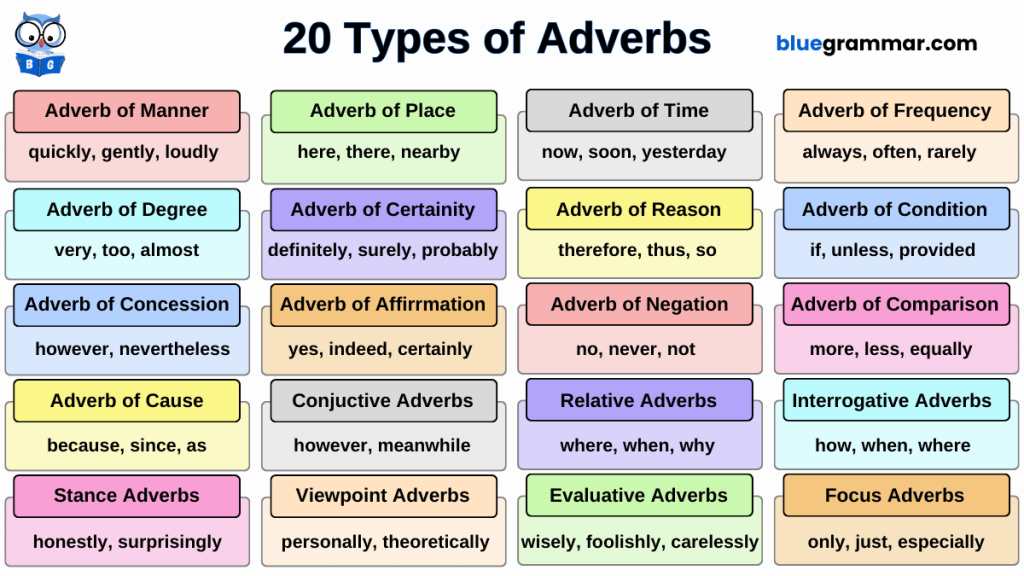
Definition of an Adverb
An adverb is a word that modifies a verb, an adjective, or another adverb. It provides us with further information about a verb, adjective, or another adverb. It tells us in what manner, at what place, or at what time something happened or was done. Look at the examples below:
Ali walks swiftly.
She took the grocery out of the shopping bags very carefully.
That is a really sweet child.
In the first example, the adverb “swiftly” is modifying the verb “walks” and is telling us the manner in which Ali walks.
In the second example, the adverb “very” is modifying another adverb, “carefully.”
In the third example, the adverb “really” is modifying the word “sweet,” which is an adjective.
Kinds of Adverbs
Adverbs are categorized into many kinds, such as adverbs of time, adverbs of place, adverbs of frequency, adverbs of degree, adverbs of manner, adverbs of reason, relative adverbs, interrogative adverbs, and adverbs of affirmation and negation.
Adverbs of Time
Adverbs of time tell us when an action was performed. These answer the question: When? Common words that fall under this category include:
Ago, before, after, later, already, now, never, formerly, soon, since, etc.
Examples in sentences:
I called my friend a few days ago.
I formerly worked at the pizza shop.
Adverbs of Place
Adverbs of place tell us where an action took place. These answer the question: Where? Common words that fall under this category include:
Here, there, up, out, in, within, away, etc.
Examples in sentences:
Mr. Saud was visiting here an hour ago.
I’m going out with my family.
Adverbs of Frequency
Adverbs of frequency show us how often or how many times an action took place. These answer the question: How often? Common words used as adverbs of frequency include:
Once, twice, again, often, seldom, rarely, always, frequently, etc.
Examples in sentences:
I often go to visit my grandparents.
It rarely rains around here.
Adverbs of Degree
Adverbs of degree inform us about the extent to which something happens. These answer the question: How much? Adverbs of degree are also known as adverbs of quantity. Common words used as adverbs of degree or quantity include:
Too, any, almost, so, pretty, rather, quite, partly, altogether, enough, etc.
Examples in sentences:
I was pretty busy yesterday.
The sauce I bought today was good enough for making my pizza.
In the above examples, the words “pretty” and “enough” both answer the question of how much.
Adverbs of Manner
Adverbs of manner give us information about how or in what manner an action is performed. These answer the question: How? Adverbs of manner are usually derived from adjectives and mostly end in “-ly.” Common words that fall under this category include:
Swiftly, clearly, foolishly, well, so, slowly, etc.
Examples in sentences:
Hassan caught the loose snake bravely.
Her hair is always well-combed.
She should do so.
Adverbs of Reason
Adverbs of reason state the reason or cause of an action. These are also known as adverbs of cause and answer the question: Why? Common words in this category include:
Because, hence, therefore, so, etc.
Examples in sentences:
I, therefore, went to the market by myself.
He was hungry, so he went to the restaurant.
Adverbs of Affirmation and Negation
Adverbs of affirmation confirm or declare something as true. These validate statements. Common words include:
Surely, certainly, definitely, very, obviously, yes, indeed, etc.
Examples:
Surely, it rained yesterday.
I am obviously going to get an A+ on my test.
Adverbs of negation express denial of a statement, action, or idea. Common words include:
No, never, invalidly, etc.
Examples in sentences:
He never went to Italy.
I no longer like to play table tennis.
Relative Adverbs
Relative adverbs introduce an adjective clause. These include: When, where, and why.
Examples in sentences:
That was the reason why Harris came.
The place where I parked my car is very deserted.
She forgot the time when we went to the States.
Interrogative Adverbs
Interrogative adverbs are used to ask questions. They are placed at the beginning of a sentence containing a question. Common words include:
Why, where, how, when.
Examples in sentences:
When will you come to visit?
How was the roast cooked?
Degrees of Adverbs
Like adjectives, adverbs also have degrees of comparison. However, only adverbs of time, degree, and manner can be compared. Adverbs such as now, then, there, once, etc., cannot be compared due to their nature.
Degrees of Comparison
Adverbs of manner, degree, and time often change in form to indicate comparison. The extent to which these adverbs change determines their degree. These degrees are called degrees of comparison.
There are three degrees of comparison: Positive degree, comparative degree, and superlative degree.
Positive Degree
A positive degree adverb is in its simplest form, without any comparison. It simply indicates the presence of a quality.
Examples:
She walked slowly.
The car is parked at a near location.
Comparative Degree
The comparative degree of an adverb shows that a quality is present to a greater extent in one thing compared to another. This degree is used when comparing two things.
Examples:
She walked more slowly than her friends.
The car is parked at a nearer location.
Superlative Degree
The superlative degree of comparison is used when the quality is at its highest level compared to multiple things or people.
Examples:
Of all the people, she walked the most slowly.
The car is parked at the next location.
In the above examples, we have compared one thing against multiple others, making it the highest form of comparison, thus forming the superlative degree.